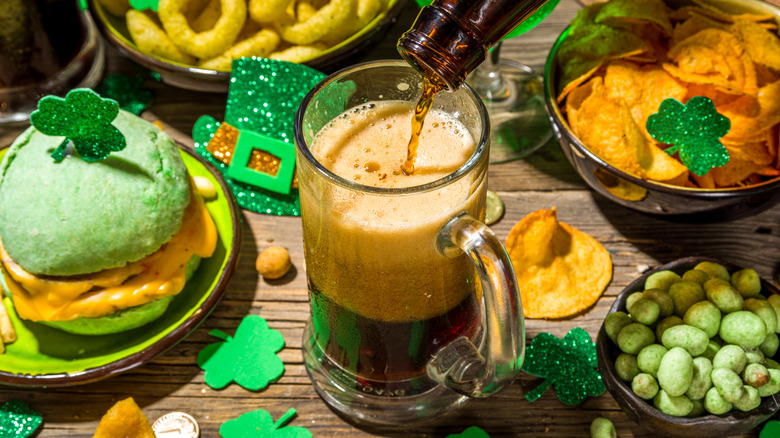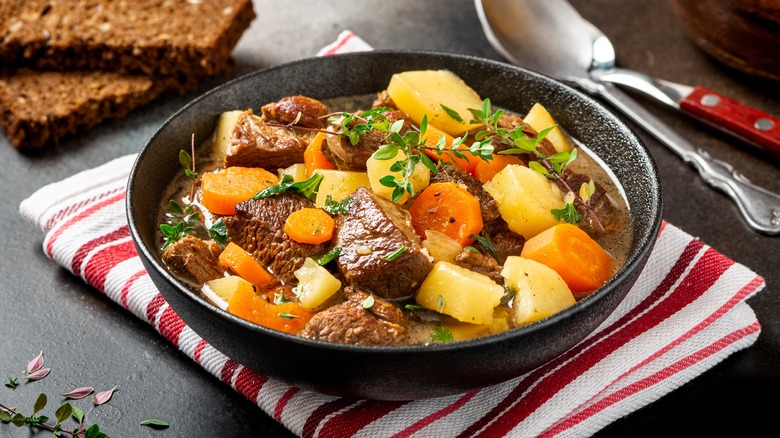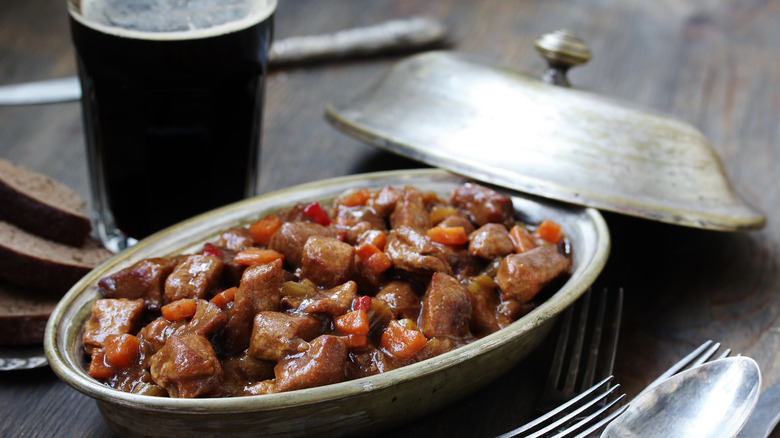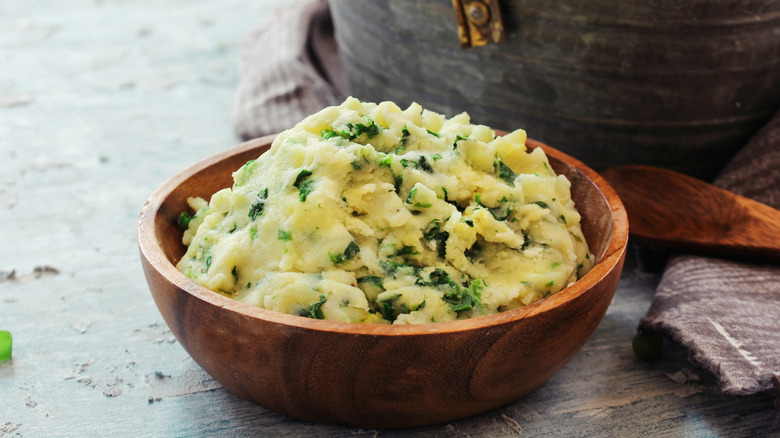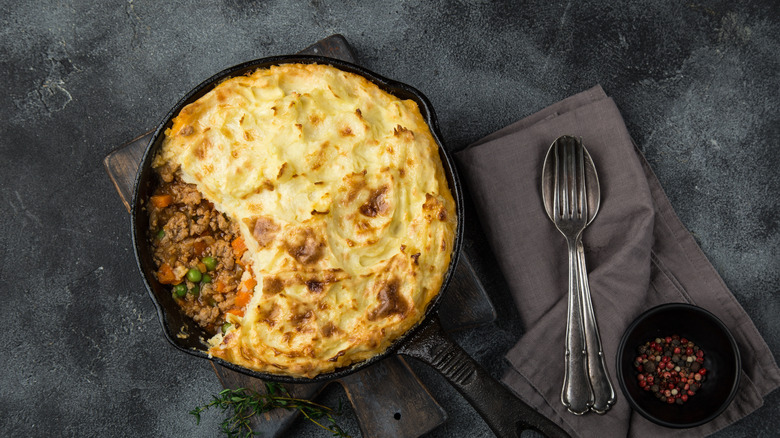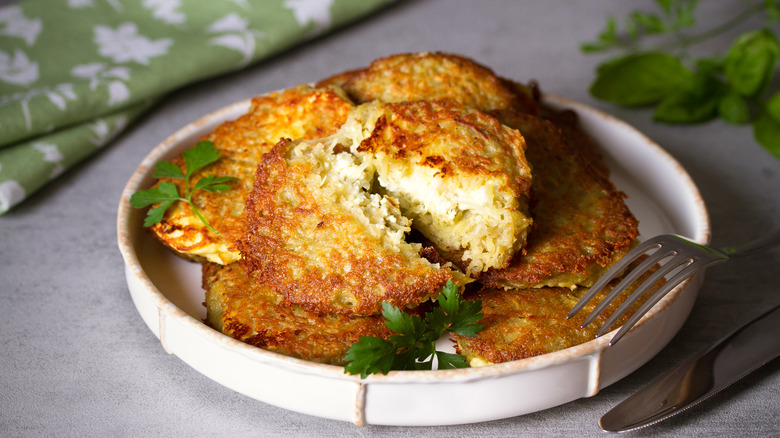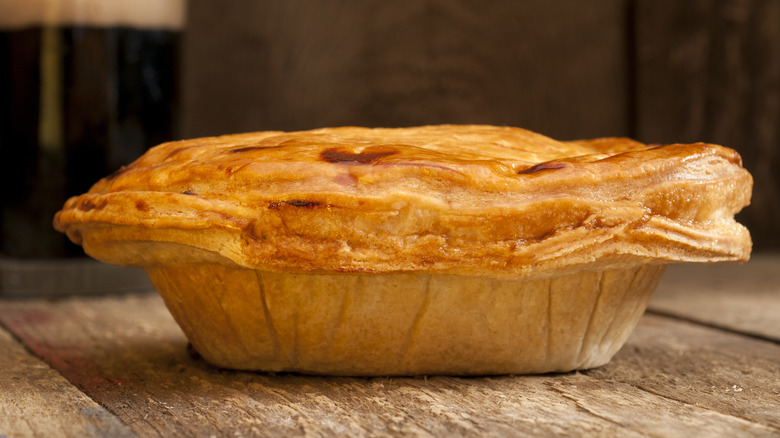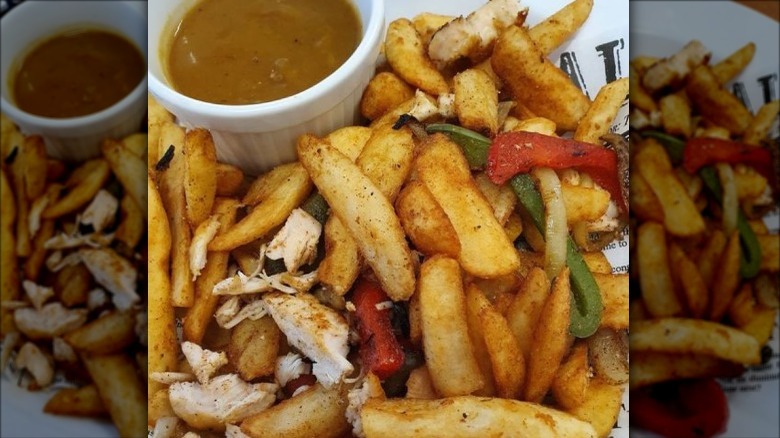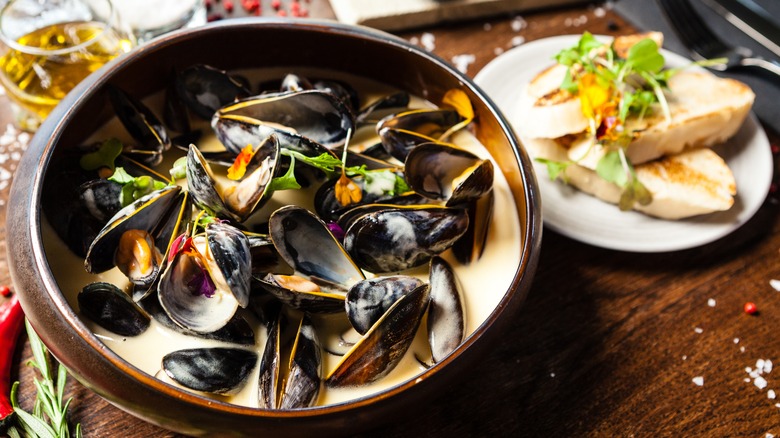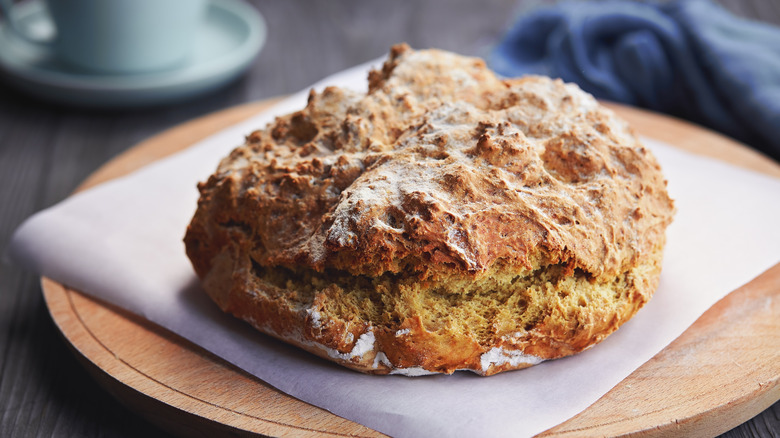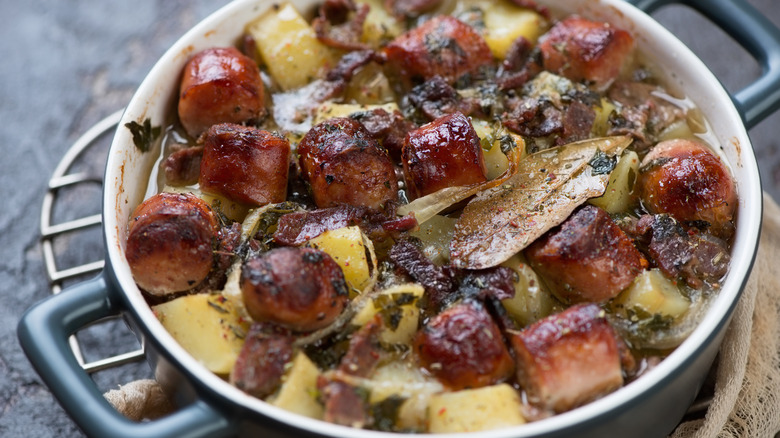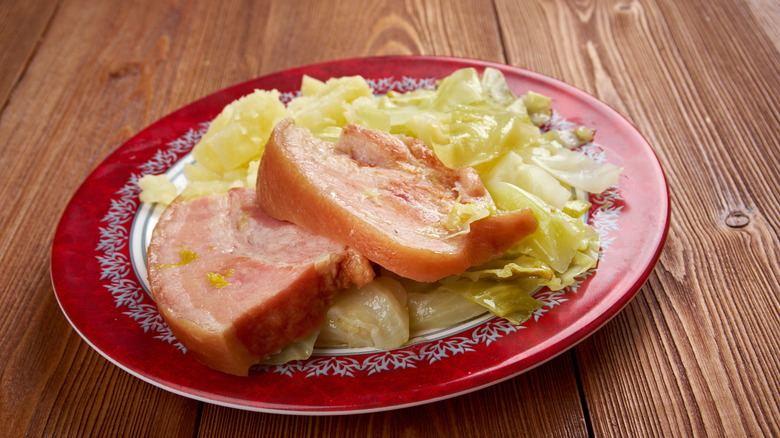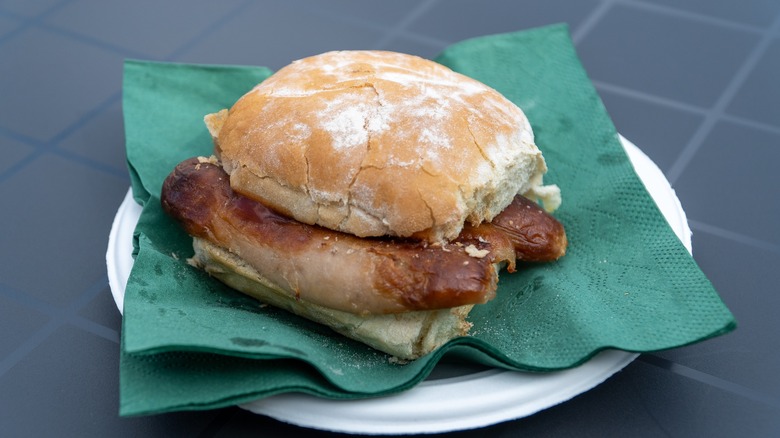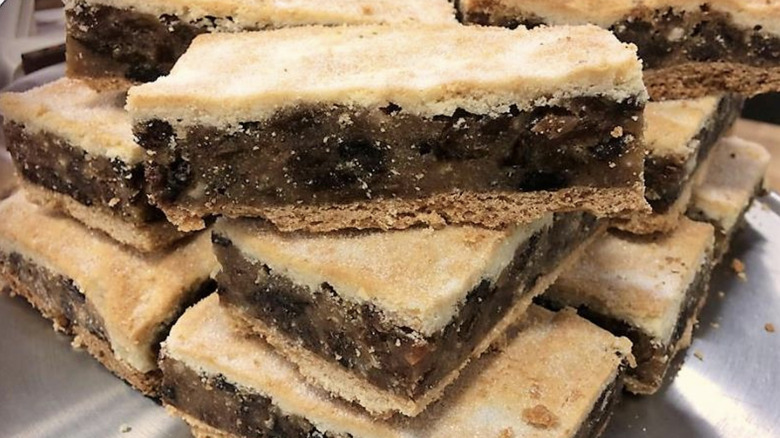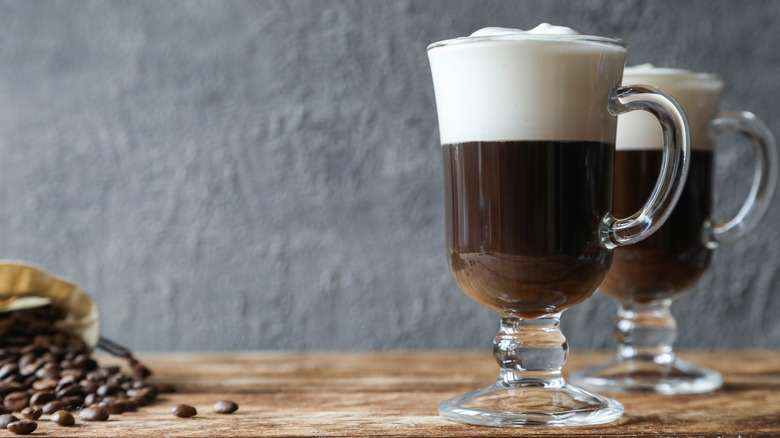14 Foods To Eat On St. Patrick's Day If You Don't Fancy Corned Beef
With St. Patrick's Day fast approaching, you're probably thinking about how to commemorate this favorite Irish holiday. Some obvious choices include wearing green and drinking Guinness or Jameson, but you will need some food to go along with that. When it comes to traditional dishes, among the wide variety of choices that pay homage to the Emerald Isle, somehow we always get stuck with corned beef as the most typical and most accessible option, but as it turns out, the corned beef that often graces the table on St. Paddy's is not all that Irish.
The story is a bit complex: Though Irish people were known for their cured salted beef, they were mostly involved in its production and were less likely to consume it due to its high cost. The situation changed in the U.S. as Irish immigrants had more financial power. They started consuming American-style corned beef, which was different from the dish they had in Ireland. American corned beef derives from Jewish culinary tradition, but it became a favorite among the Irish, and it then naturally progressed to become the most typical dish we eat on St. Patrick's Day.
This is an excellent roundup if you're not a corned beef fan or want to explore the diverse selection of traditional Irish dishes. It includes comforting and homey Irish favorites that provide a new perspective on what makes classic Irish cuisine.
1. Irish stew
If you're looking for a comforting Irish dish that screams tradition, Irish stew is your safest choice. This soothing and hearty meal relies on simple, everyday ingredients that were readily available to Irish peasants hundreds of years ago. Traditional Irish stew is always prepared with lamb or mutton because they were the most common proteins in the Irish diet before the big emigration wave to the U.S. As stews are ideal for less prestigious cuts of meat, Irish stew was designed for tougher, cheaper pieces that were generally less desirable. The long cooking process would tenderize the meat.
Though the recipes for classic Irish stews vary and are usually influenced by regional preferences, you will typically find it packed with potatoes — probably the most important ingredient in the traditional Irish diet — and carrots or other root vegetables, all slowly simmered in a well-seasoned, hearty broth. Although it is a somewhat modest affair, Irish stew is the dish that will warm your soul and is one of the best representatives to honor the classic Irish culinary tradition.
2. Guinness and beef stew
Though Guinness and beef stew sounds like an ultimate traditional dish of unquestionable Irish heritage, the truth is more complex. This hearty stew does stem from Irish cooking tradition, and it was modeled on the classic Irish stew, but its origin is mainly attributed to Irish immigrants in the U.S. This is most obvious in the addition of beef as the primary protein inside the stew. Unlike lamb or mutton, beef was not commonly used in traditional Irish cuisine, and it is more in line with American cooking practices, as here it is a protein of choice for stews and similar dishes. Along with flavorful broth, onions, garlic, herbs, and root veggies, this rich stew also includes a nice dose of Guinness — the roasty stout that is known for its bold flavor and aromas.
Guinness and beef stew is slowly simmered until the beef is thoroughly tenderized. The long cooking process will allow all of the dish's strong elements to blend into a beautiful medley of sweet, earthy, and roasted flavors. This stew is not a light meal. The rich broth and flavor-packed meat need a nice, mellow accompaniment, and mashed potatoes would be an excellent choice for a side dish.
Any Guinness would be a suitable option for this stew, but a slightly more potent Special Export might work better as it has more flavor than the classic version. If Guinness is not at hand, any nicely crafted stout would be a good choice.
3. Colcannon
Colcannon is a straightforward, unpretentious dish best described as an upgraded version of mashed potatoes. The base of this Irish classic is made with a standard blend of mashed potatoes, butter, and seasonings, but colcannon goes that one extra step forward and incorporates finely sliced green veggies and herbs. The most common add-ons in colcannon are leeks and cabbage, but contemporary variations will include virtually any greens. Though we're always in for a dollop of mash, we rarely see its potential as this neutral blank canvas that can be enriched with additional ingredients to show off its versatile character.
Colcannon was initially invented to act as a side dish, and it's hard to think of anything better to serve with other Irish classics, but who's to say that you cannot turn this traditional specialty into a star and serve it as the main course? Try to top it with fried bacon bits and drizzled with fat to see how this simple concoction can make a filling, hearty meal.
In Ireland, colcannon is mainly associated with Irish festivals — Halloween included — and was often a part of festive rituals. As it's a true representative of classic Irish cuisine, it would be a great choice to serve on St. Patrick's Day if corned beef is not your thing. Not to mention that it is a vegetarian-friendly dish (just don't add that fried bacon we mentioned).
4. Shepherd's pie
Classic shepherd's pie combines ground meat that is sautéed alongside diced carrots, celery, and onions. When the meat is cooked and caramelized, the mix is placed on the bottom of the dish and is then covered in a thick layer of mashed potatoes. The whole thing is left in the oven until the meat and veggies cook through and the mashed potato crust becomes firm and crispy on the edges. Shepherd's pie comes in many forms and sizes. The ingredients can be modified, and if you're a fan of potatoes (and who isn't), you can add another layer of mash to the bottom of the dish. Shepherd's pie is a wholesome meal and a great option to serve for St Patrick's Day, and if you're wondering why an all-time British favorite would be appropriate for one of the biggest Irish holidays, it turns out that shepherd's pie is not entirely British.
Shepherd's pie is descended from a dish called cottage pie that was enjoyed by people in both the U.K. and Ireland. Based on the close connection of the two neighboring nations, it's not surprising that they would also share similar eating habits and typical dishes, so feel free to indulge in this classic as a nod to Irish culinary tradition.
5. Boxty
Potatoes are the king of Irish cuisine. Unsurprisingly, when talking about traditional Irish dishes, many will include potatoes, and boxty might be the best representative of a simple, humble dish that fed the nation throughout its history.
At its most basic, boxty is a simple potato pancake consisting of thin threads of grated potatoes that are held together with a mix of eggs, flour, and a splash of milk. The chunky batter is well seasoned and then fried until golden and crispy. These potato pancakes are easily adapted with different flavorings, so you can freely add whatever you find suitable. Although they are not lavish or elegant, boxty pancakes represent what traditional Irish cuisine stands for: A few simple ingredients that everyone has at home made into a flavorful and nutritious dish. You can have them on the side with stews or casseroles, but these crispy treats can also be eaten on their own; just make sure to serve them with dipping sauce. They make an excellent, hearty breakfast, a great snack, or a filling dinner. You can even drizzle on some honey and eat them as dessert.
6. Beef and Guinness pie
How can you make beef and Guinness stew better? The answer is simple: Make it into a pie, as there is nothing better than pairing flaky crust with a rich, bold stew packed with meat, veggies, and stout. This pie will start the same way you'd make a classic beef and Guinness stew. The blend of root veggies, diced beef, Guinness, and onions will get a slow and long simmer until the meat is tender and all flavors are thoroughly infused. The stew will attain subtle sweet earthiness from the meat and the veggies and the beer will round out the entire thing by lending those distinctive roasty notes that perfectly match beef.
Though you'll probably want to immediately dig into the stew, the dish will come out even better if you transfer it into a pie dish, top it with a thick layer of pastry, and then bake it until the top is nice and golden. The best thing about this pie is that it has all the elements to be a stand-alone main course and there is no need for any side dishes. The stew is hearty and filling enough on its own and the pastry crust is a perfect addition that will provide some carbs and make the texture more exciting. If you're serving a big group this St Patrick's Day, this pie checks all the boxes for an ideal, crowd-pleasing dish.
7. Spice bag
Spice bag is the most unconventional addition to the list. If you've never heard of it (which isn't surprising), a spice bag is a somewhat unusual combination of slightly thicker-cut fries, fried chicken, bell peppers, onions, and spices. The origin of the dish is vague, but it is mainly associated with Dublin, where you will easily find it in many Chinese restaurants. The exact ingredients will vary depending on the location, and the exact spices are rarely disclosed. Although it's not a standard part, a thick curry sauce is sometimes served on the side.
Though you might question the mere existence of this mix, the Irish are huge fans, and they even voted spice bag as their favorite takeaway dish in 2020. Perhaps there is something more to this unusual concoction, and this St. Patrick's Day might be the perfect time to see what the fuss is about. This spicy mix is a favorite late-night snack, and many believe it's a great hangover cure, so maybe that's the secret of its success.
8. Mussels
Mussels might be one of the unexpected additions to this list. Though Ireland is an island surrounded by the sea, the nation is not usually associated with seafood. Fish and shellfish are a part of the Irish diet, but they are simply less common and often slip off the radar when we talk about traditional Irish food. Mussels might be the best and the most sustainable choice for St Patrick's Day if you want to give the nod to Irish maritime ingredients.
Mussels easily incorporate into Irish cooking traditions as they are versatile enough to effortlessly pair with classic Irish ingredients. As Ireland prides itself on its fine dairy products, fresh cream would be the obvious choice here, but any buttery sauce would work as mussels like silky smooth textures and creamy flavors. Alcohol is always an excellent addition with steamed mussels, and cider and stout, as two outstanding Irish alcohols, would both make glorious sauces for mussels.
9. Irish soda bread
Irish soda bread doesn't need much introduction. This classic baking soda-leavened bread has long escaped the borders of its native country and found its place in professional and home kitchens around the world. It has been particularly welcomed in the U.S.
As the name suggests, the bread is made with soda that acts as a leavening agent that helps the bread rise and puff up. Other than that, the classic soda bread recipe usually calls for flour, salt, and buttermilk, though American versions often add butter, eggs, and sometimes a handful of raisins. This bread is assembled quickly, but it results in a very satisfying meal that can be easily adapted according to preference, so it's not surprising that it enjoys so much popularity.
Because of its heritage, Irish soda bread is the best bread choice for St. Patrick's Day, but it should not be restricted by dates or seasons. It is the ideal everyday bread suitable for any time of the day. You can make it into a sandwich or serve it with a meal. American versions would be especially nice with a sweet combination of butter and fruit jams.
10. Dublin coddle
Dublin coddle, which also sometimes goes by the name Irish coddle, is perhaps the best example of a traditional Irish dish that relies on simple ingredients and classic cooking techniques but results in a wonderful meal that feeds the stomach and the soul. Traditional coddle is a versatile dish that originated as a nutritious wintertime option that was assembled with several ingredients that were always readily available. Though there is no set recipe, you will always find some combination of sausages, bacon, onions, and potatoes layered inside a heavy-bottom pan. The ingredients are cooked in a lightly seasoned broth and the dish is left to simmer in the oven for several hours. You would always want to serve it with bread on the side to help you mop up all that delicious cooking sauce.
Coddle allegedly originated in the 18th century, and it's one of those poor man's dishes that was permanently integrated into the Irish culinary narrative. It's a great choice for a chilly St. Patrick's Day.
11. Bacon and cabbage
Instead of corned beef and cabbage, opt for bacon and cabbage as an authentic Irish dish for this St. Patrick's Day. The bacon in question is not the typical kind you would find in the U.S. that is made from fat-streaked pork belly. In Ireland, bacon is taken from the back of the pig and typically has more meat than fat. For this dish, thick bacon slices are cooked with cabbage until the flavors are well combined. The dish is usually served with boiled potatoes and often comes doused in a creamy, parsley-based sauce.
Irish are big fans of this classic, and the dish was even proclaimed as a favorite traditional dish in the country, so we can't think of a better option for St. Paddy's Day. The only addition we would have is a pint of Guinness on the side to complete this hearty Irish feast.
12. Blaa
Essentially, blaa is a plain bread roll with an uneven round shape. The top is covered in a golden-colored crust, while the center of the roll is soft, tender, and pliable. Despite its unusual name, this is a simple bread roll with a long history in the Irish culinary narrative. Blaa originated in Waterford sometime in the 17th century and is still exclusively associated with its place of origin. Initially invented to repurpose extra bread dough, blaa quickly gained recognition, becoming a favorite baked product in the city. This bread roll might be a confusingly simple addition to the list, but it's such a significant Irish product that it holds the protected PGI status — which stipulates that blaa can only be produced in Waterford using specific ingredients and following traditional production methods. As a real example of Irish culinary heritage, this roll certainly deserves to be on the list of items that should be munched down on St. Patrick's.
It is believed that the name blaa stems from French — Huguenots were allegedly the first to mix and bake these rolls at local bakeries — and it could potentially have its roots in the ancient French word for bread (blaad) or for white color (blanc). Blaa can be enjoyed like any other bread roll. Serve it on the side, eat it as a snack, or slice it and stuff it with your favorite spreads and toppings — anything works here.
13. Gur cake
Gur cake is not something you will usually find on the list of classic Irish dishes, which seems a bit unfair, as this simple treat is an Irish dessert with a lot of history that speaks volumes about Irish culinary tradition. Gur cake consists of a pastry shell filled with an aromatic mix of bread chunks soaked and flavored with dried fruit, black tea, and spices. The soft filling is nestled between thinly rolled pastry sheets and the whole thing is baked until completely set and golden. The cake is served sliced and usually comes topped with a generous amount of powdered or caster sugar.
Gur cake originated in the 1930s when Ireland faced economic hardship and an unstable political situation. It was invented by local bakers to use up all the stale bread and make it more palatable by turning it into dessert. Despite its frugal background, Gur cake is a delicious treat that packs much flavor inside the soft filling. It is an ideal tea cake, and the best thing about it is that you can easily adapt it to your taste. Many local bakeries in Ireland offer Gur cake, but you might also find it labeled as Chester cake or fruit slice.
14. Irish Coffee
Irish coffee is officially classified as a drink, which might make it the oddball on the list, but this luscious coffee-based beverage is so rich and potent that you can easily categorize it as a liquid dessert. It may also be the best way to wrap up St. Patrick's Day festivities. Classic Irish coffee combines freshly brewed coffee with Irish whiskey and cream. Though the combination doesn't sound overly complicated, the result is a perfectly balanced warm cocktail that is packed with creaminess and balanced with caffeine and alcohol. Caramel and spice notes from the whiskey will provide a nice backbone softened by the silky cream. Irish coffee is usually lightly sweetened and should always be served warm. You can quickly whip it at home; just make sure to use the best quality ingredients, including well-crafted whiskey, good-quality coffee, and real, fresh cream.
If you'd like to add an extra kick to this creamy concoction, try switching cream with Baileys, the flagship Irish liqueur that combines cream and Irish whiskey. A dash of Bailey's will deliver the creaminess but with an added touch of toffee flavors and a slightly higher ABV.
